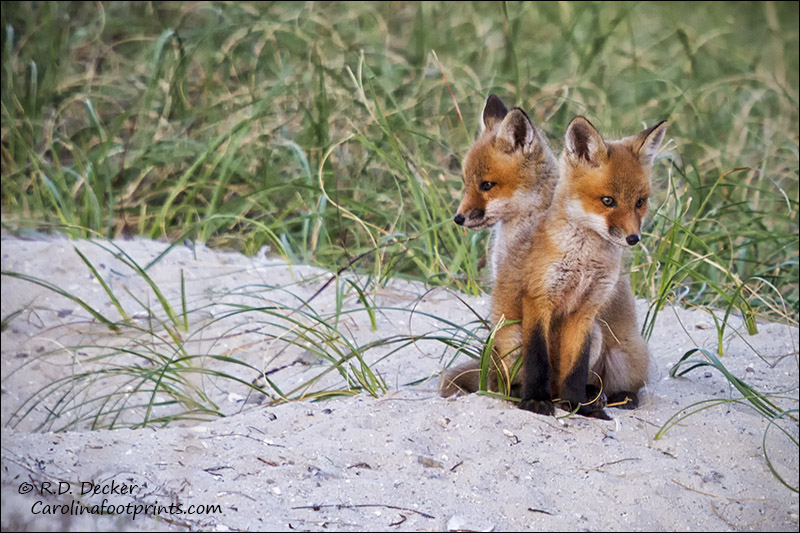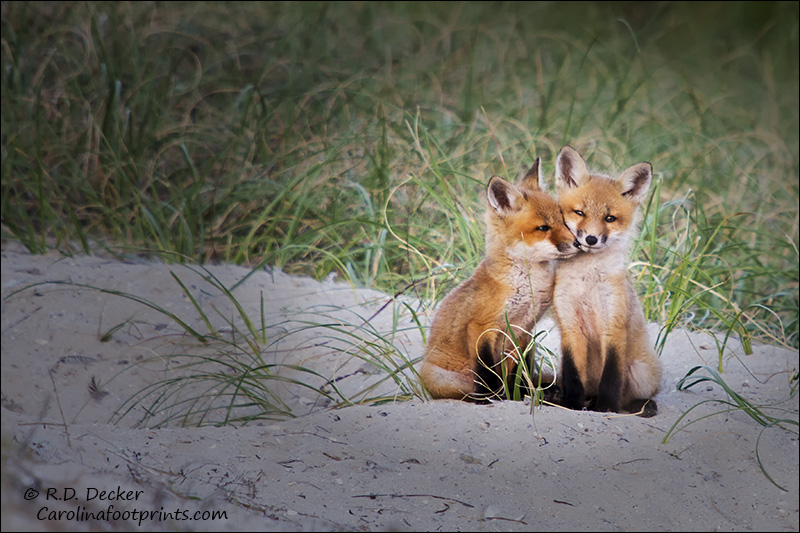When I visit my favorite photography areas I usually do a bit of scouting after I’ve made the shots I planned for. Last winter I came across a fox den while scouting. I made some mental notes of the location with plans to revisit it in the spring. A few evenings ago I was photographing wild horses. The horses were being less than animated and, honestly, I already have thousands of images of wild horses with their heads down feeding. The clouds in the sky weren’t overly interesting and I didn’t see the prospect for good sunset shots being very high either. With those considerations in mind I decided to call it an evening and head back to my kayak. However, I thought I’d go a bit out of my way and see if there was any sign of activity around the fox den. Activity there was!
As I slowly and quietly moved into a position where I could get a peak at the fox den I noticed the outline of a hear with pointy little ears through the tall glass. Not only was it an active den the kits were outside! The problem was from my location I didn’t have a clear view of the den. The den was hidden behind tall grass. To make matters work the sun was directly behind the den. The only chance I’d have to get a shot would require repositioning myself for a view of the den. Now foxes have a reputation for being shy, evasive animals. In my experience it’s an accurate reputation. In order to get a shot I’d have to move into a position where there was no cover and do so without spooking the little foxes. I figured my odds were low but I just had to give it a try.
First I noted the wind direction and plotted a course that would keep me down wind of the den. I looked at the route and could see that I would be out of view of the foxes… unless they moved up on top of the dune above their den. I set a goal of the to of a small dune about 150 or 200 feet from the den that would give me a clear view of the foxes. Upon reaching the spot I was a bit surprised to see the foxes were still outside the den. One stared intently at me as I sat very, very still. After what seemed like a long, cold stare the little mammal went back to business. For the next forty-five minutes to an hour I’d take a few shots, push my tripod and camera a foot or so in front of me, scoot up behind it and take a few more shots. Slowly I inched closer and closer to the kits. I managed to work within about one-hundred feet of the little guys before that light became too dim to shoot.
I’m a little surprised that I was able to get that close to these wild animals. I wasn’t inside a blind nor was I wearing camo. My clothes were earth tones but foxes, like other canidae, are color blind. The two things I had working in my favor was wind direction and the fact that the sun was directly behind me. Try looking directly into a low, setting sun and you’ll understand how difficult that can make things. I’ll check these images up to a small dose of apply field skills and a big helping of luck.





